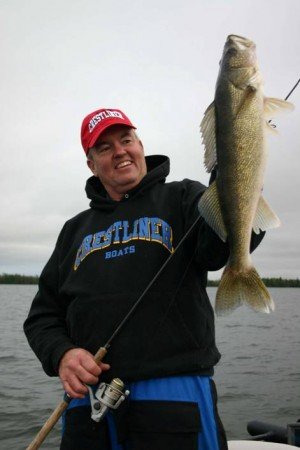 With June in full swing, the action with summer walleyes is really starting to heat up. When the sun begins to push water temps into the lukewarm range, walleye activity increases accordingly. Although some may find the going a little tough this time of the year, those that are willing to change how and where they fish for walleyes, can still make some excellent catches.
With June in full swing, the action with summer walleyes is really starting to heat up. When the sun begins to push water temps into the lukewarm range, walleye activity increases accordingly. Although some may find the going a little tough this time of the year, those that are willing to change how and where they fish for walleyes, can still make some excellent catches.
As walleyes vacate early season hideouts, in favor of deeper summer haunts, there’s a period of time when fish are in transition. When there aren’t that many fish shallow, and there aren’t that many deep, fishing can be a bit sporadic.
However, as more and more fish show up at their new ‘home for the summer’, the action can only get better. Summer locations can include deep, offshore structure, like sunken islands, bars and humps. Look for structures that have most of their mass above the thermocline. Structure that is too deep will see little walleye activity, if any, until after the fall turnover.
With an increase in numbers, your chances for finding a few active ones greatly increases. Walleyes don’t all do the same thing at the same time, and when it comes to feeding movements, it’s like they take turns. Some will be totally inactive, some may be starting to stir a little but won’t move far to take a bait, and others may be extremely aggressive and willing to take just about anything you put in front of them. Those are the traitors that can give up a school’s identity, and location.
One of the best places to start your search is near a break line that drops quickly into deeper water. The top of deep structure can play host to perch, baitfish, insects and crayfish. Active walleyes will often be found cruising the top edge of a break, where they can quickly move up to grab a bite to eat.
Larger structures will often out-produce the smaller ones, simply because they can offer more feeding opportunities for ‘eyes on the prowl. However smaller ones can be easier to fish, because of their simplicity. There’s only so many places they can hide. You can quickly check the top, the sides, and the base of the breaks, with a graph or flasher. If they’re there, go ahead and fish, if not, it’s time to move on.
The larger structures will require you to spend a little time watching your electronics, and less time fishing. Walleyes can be anywhere, and it doesn’t pay to fish where they’re not. To find them, you can save some time by cruising the entire structure, making note of where you saw the largest concentrations.
Another place to find summer ‘eyes that is often overlooked, is the transition line where hard bottom meets soft. Where gravel or rock, changes to mud or silt, a transition line is created, and can concentrate fish. Transition line fish see little attention by most anglers, and can be one your best bets for a shot at a real hawg.
Once you’ve found a potential area, and have marked at least a few fish, it’s time to get down to business. The early season presentations of rigging and jigging may still produce, but quicker methods, like trolling spinners, really start to pick up. Rising water temps can push a walleye’s metabolism to the boiling point, and increase the chances that he’ll react to a speedier technique.
One of the top summer producers is a spinner and live bait combo. Spinners possess an element of speed, and it’s the speed that can often nail walleyes with a bad attitude. To get a spinner in the ‘zone’, it’s hard to beat a spinner and bottom bouncer combination. A bouncer can get a bait where you want it , and run relatively snag free. Bouncers in the two to three ounce range are the ticket, and allow the user to keep the bait close to the boat. By keeping it close, you can react to sudden depth changes.
You can also lift the bait off the bottom to get it in front of any high riding fish that you mark on your depthfinder. You’ll want to keep the spinner snell short, let’s say three feet or less. Longer snells allow for more drop, and result in more snags. The odds on favorite bait for dressing a spinner rig, is a big fat juicy night crawler. However leeches can be effective at times, and minnows can turn late summer ‘eyes when nothing else will.
Mid summer walleye fishing can get awful tough, but it doesn’t have to be that way. The key is to find them, and then find out what they want. Quite often, what they want is something with a little speed. Think about it, not only does a walleye’s metabolism increase, but so does it’s prey. Everything is moving at a faster pace, and it’s a fast paced world we’re living in. See you on the water.
by Ron Anlauf
PWT Champion